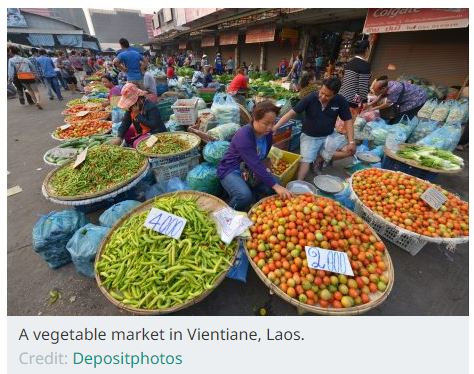Inflation in Laos Continues to Rise, Reaches 23-Year High
While inflation is projected to fall in 2023, there is no quick fix to the country’s economic troubles.
Inflation in Laos continues its alarming upward trend, reaching 40.3 percent year-on-year in January, the government announced this week, the highest figure that the country has reported since 2000.
According to a report issued by the Lao Statistics Bureau on Monday, the soaring price of fuel, gas, and other imported goods, compounded by the depreciation of the Lao kip, are among the main factors driving inflation.
The report found that the inflation was led by spikes in the price of communications and transport, which rose 49.9 percent year-on-year, creating flow-on effects into other parts of the economy. The price of food and non-alcoholic beverages jumped 47.1 percent, while the cost of medical care and medicine increased by 42.2 percent.
Inflation began to take off in the second quarter of last year, when Laos’s economy, already severely impacted by the COVID-19 pandemic, was hit by a combination of rising oil prices and a rapidly depreciating currency. The Lao kip was trading at around 9,300 kip to the dollar in September 2021, a rate that has since climbed to nearly 17,000 as of last month. It has also depreciated sharply against the Thai, Vietnamese, and Chinese currencies, raising the cost of imports from these three key trading partners.
A report by the U.S.-funded broadcaster Radio Free Asia (RFA) found that “even normally well-off state employees are feeling the squeeze.” The report cited several civil servants as saying that the inflation had drastically increased the cost of making ends meet.
“We’re seeing a lot of hardship,” a public sector worker in Phongsaly province, along northern Laos’ border with China, told RFA. “The only people who aren’t affected are high-ranking officials.” Added a state employee from Bokeo province in the country’s northwest, “Things are really tough compared to a year ago.”
About 500,000 people – around 21 percent of the country’s workforce – are unemployed due to the economic downtown, the Ministry of Labor and Social Welfare reported late last year.
The alarming inflation figures are the latest indication of the economic storm that continues to swirl over the country’s heavily debt-burdened economy. Overall, Laos’s average inflation came to 23 percent for 2022 – the highest rate among the 10 member states of the Association for Southeast Asian Nations (ASEAN) – up sharply from 3.8 percent in 2021. According to the Asian Development Bank, this will fall to 10 percent in 2023 – the Lao government is itself hoping to bring it under 9 percent – but is still likely to put pressure on the country’s new prime minister, Sonexay Siphandone.
Sonexay took office in early January after the resignation of his predecessor Phankham Viphavanh. Phankham ostensibly stood down for health reasons, but the ruling Lao People’s Revolutionary Party (LPRP) likely ordered him to fall on his sword due to the country’s dire economic situation. “In the current situation, our country is experiencing a lot of hardships. I’m not able to do this difficult job any further,” he said in a speech at the Lao National Assembly.
Sonexay, the son of LPRP old-guard figure and former party chief Khamtay Siphandone, began his new term this year promising to “raise the spirit of the revolution to the highest level.” Since then, his government has taken a number of additional measures to get inflation under control, including ordering all currency exchange shops to close, and banning the import of meat and agricultural products that are produced domestically. But given the country’s debt burden, and the broader structural problems with the economy, there is likely a long road out of Laos’ current economic predicament.
Source: https://thediplomat.com/2023/02/inflation-in-laos-continues-to-rise-reaches-23-year-high/


 Thailand
Thailand




